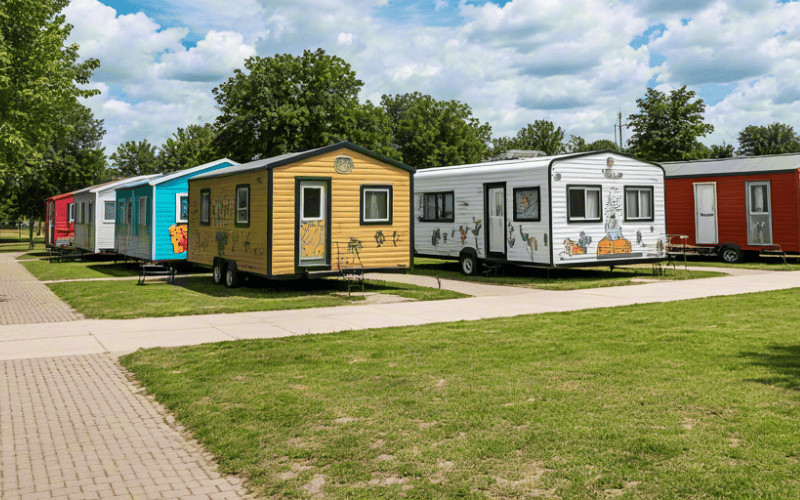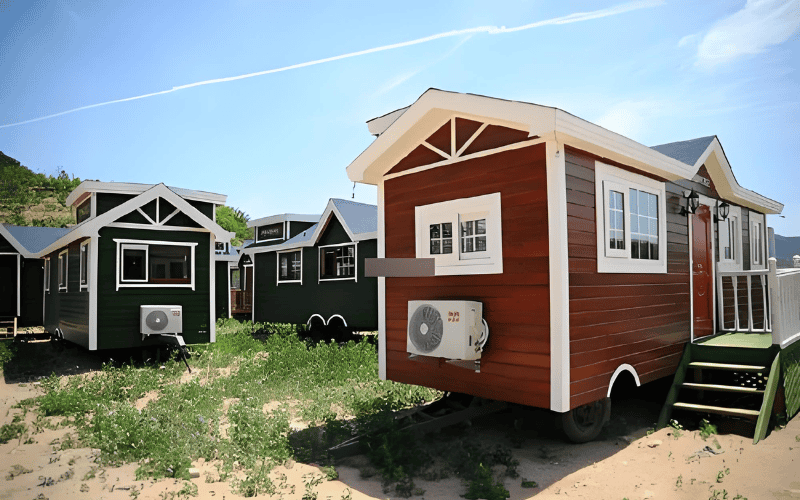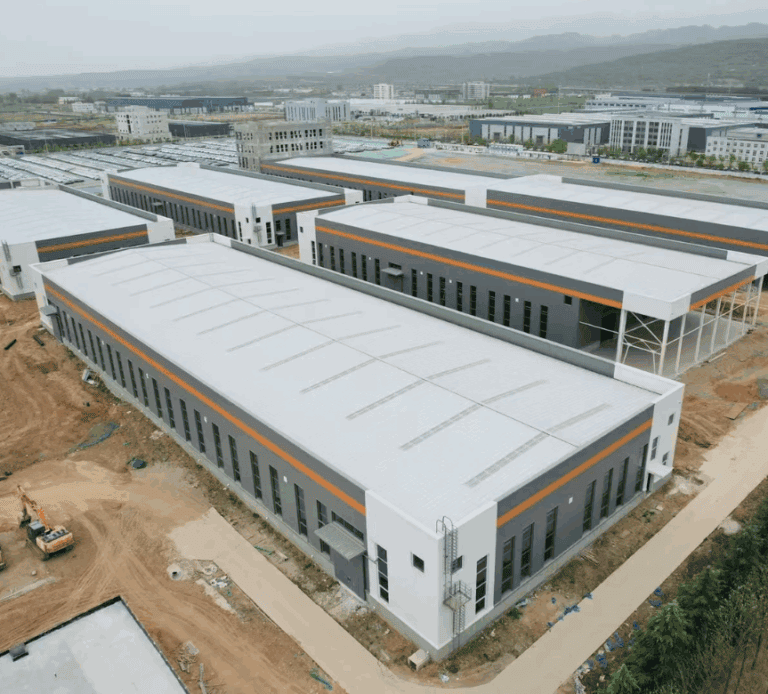Understanding how many mobile homes can fit per acre starts with zoning and land use. In most cases, one acre can hold 4 to 10 mobile homes, depending on local regulations, home type, and spacing requirements. Single-wide homes allow greater density, while double-wide and modular units require more room for access and utilities.
The exact number also depends on setbacks, infrastructure, and available services. Counties with public sewer and water systems permit higher density, while rural areas with private wells and septic tanks require larger lots. Land shape, driveways, and utility connections further influence how efficiently each acre can be used.
This guide explains how zoning and lot size affect land requirements, how to plan efficient layouts to maximize usable space, how density differs by state across Alabama, Texas, Georgia, South Carolina, and North Carolina, and which development and infrastructure factors determine long-term success for any mobile home park project.
How Many Mobile Homes Can You Put on 1 Acre of Land?
Typically, between 4 and 10 mobile homes can fit on one acre, depending on zoning laws, home size, and infrastructure. Single-wide homes allow higher density, while double-wide or modular units require more space. This section explains how zoning, setbacks, and layout design affect how many mobile homes can be placed on one acre of land.
Zoning and Local Regulations
Zoning laws dictate the maximum number of mobile homes that can be placed on an acre and may also regulate the type of homes allowed. Residential or agricultural zones often have stricter limits, while commercial zones or designated mobile home parks can offer more flexibility. It’s crucial to consistently review local zoning regulations to guarantee adherence to them.
- Minimum Lot Size for Mobile Home: Many areas require a minimum lot size per mobile home, typically ranging from 2,000 sq ft to 10,000 sq ft or more, depending on the zoning area (e.g., rural, suburban, or mobile home park).
- Setbacks: Regulations often specify the distance between homes, property lines, and roads. Common setbacks include:
- 5–20 feet between homes
- 10–25 feet from property lines
- 10–50 feet from roads or water features
- Density Limits: Zoning may limit the number of homes per acre. For example:
- Mobile home parks may allow 4–10 homes per acre.
- Rural areas may allow 1–2 homes per acre.
Practical Layout Considerations
- Land Shape and Size: Rectangular or square plots are more efficient for space utilization, while irregularly shaped land can limit the number of homes. Additionally, sloped areas or wetlands may reduce usable space, making flat, clear land more suitable for placing multiple homes.
- Roads and Driveways: Typically 10–20 feet wide, reducing usable space.
- Utility Easements: These usually take up 5–10 feet of space, further reducing the available area.
- Septic Systems: If not connected to a public sewer, each home might need 5,000–10,000 sq ft for a septic system, depending on local regulations and soil conditions.
Typical Number of Mobile Homes per Acre:
| Home Type | Typical Size | Units per Acre | Notes |
| Single-Wide | 14×70 ft | 8–10 | Smaller footprint allows higher density |
| Double-Wide | 24×60 ft | 4–6 | Requires more spacing and setbacks |
| Tiny Home | 8×20 ft | 10–15+ | Used in compact or park-style developments |
| SteelPRO Modular | 5×10m–5×20m | 6–12 | Custom spans, factory-direct design for optimized land use |
Explanation:
- The number of mobile homes that can fit on one acre depends primarily on zoning rules, setbacks, and infrastructure.
- Single-wides allow for higher density, while double-wides and modular units require more space per home.
- Using SteelPRO PEB modular steel structures enables flexible configurations that balance comfort, compliance, and land efficiency.
How Much Land Do You Need per Mobile Home (By Type & Zoning)
Most mobile homes require 0.25 to 1 acre of land per unit, depending on local zoning and available utilities. Rural areas often need larger lots because of septic and well systems, while park settings with shared infrastructure can accommodate more homes per acre. The following section compares lot size standards across zoning types and shows how modular steel layouts improve land efficiency.
Zoning and Lot Size
- Rural Areas: Many counties require 0.25–1 acre (10,890–43,560 sq ft) per mobile home for a single residence, especially if using a septic system and well. Some allow as little as 0.1–0.2 acres (4,356–8,712 sq ft) if utilities are pre-existing.
- Mobile Home Parks: Lot sizes shrink to 2,500–5,000 sq ft (0.06–0.11 acres) per home due to shared infrastructure, but this applies to park settings, not individual ownership.
- Suburban/Urban: 0.1–0.5 acres (4,356–21,780 sq ft) is common, depending on density rules and utility access.
Overall, zoning greatly influences land requirements: rural areas often need 0.25–1 acre per unit, while mobile home parks can accommodate 5–10 homes per acre through shared utilities and pre-engineered layouts. Using SteelPRO PEB modular steel structures further enhances land efficiency by optimizing footprints and integrating utility systems in advance.
Typical Mobile Home Sizes and Space Requirements
- Single-wide mobile homes: Typically 14 feet wide and 70-80 feet long, with a total area of about 980 to 1,120 square feet. Due to their smaller size, you can build more homes on an acre of land. On flat land, you can fit up to 8-10 single-wide homes, depending on zoning laws and setbacks.
- Double-wide mobile homes: About 24 feet wide and up to 1,500 square feet. Due to the larger area of double-wide homes, fewer homes can fit on the same acre of land. Typically, only 4 – 6 double-wide homes can be built on an acre of land, leaving limited space for roads, parking, or amenities.
- Other types of mobile homes: Tiny homes and modular units are smaller alternatives. Tiny homes range from 100 square feet to 400 square feet, while modular homes are larger than single-wide homes but smaller than double-wide homes. By choosing a smaller home like a micro home, you can fit more units — up to 15 or more per acre, depending on size and layout. This is ideal for high-density housing or mobile home parks.
Setbacks and Buffers
Setback regulations are a critical part of planning. Whether you want to know how many single wide trailers can fit on an acre or if two mobile homes can share a septic tank, always calculate the minimum space required, including setbacks from property boundaries, utility easements, and access roads. Each state—like NC or Georgia—may have unique zoning regulations impacting your mobile home lot size.
- Typical rules: 5–20 ft between homes, 10–25 ft from property lines, 10–50 ft from roads or water features.
- Example: A single-wide (14 ft x 70 ft) with 10-ft setbacks on all sides needs a lot of at least 34 ft x 90 ft (3,060 sq ft, or 0.07 acres).
Utilities
- Septic System: Requires 5,000–20,000 sq ft (0.11–0.46 acres) depending on soil percolation and local codes, often pushing rural minimums to 0.5–1 acre.
- Well: Adds 2,500–5,000 sq ft (0.06–0.11 acres) for setbacks from septic and home.
- Existing Hookups: Reduces land needs to the home footprint plus setbacks (e.g., 0.1–0.25 acres).
If you want to buy land for a mobile home, search for land for sale for mobile home or “land for trailer homes”. Inquire locally about land for modular homes and whether the land is zoned for manufactured homes, mobile homes, or modular homes. Knowing how much land is needed for a double wide mobile home or how many manufactured homes per acre ensures your investment is compliant.

How to Maximize Space and Layout for Mobile Homes
To maximize how many mobile homes fit per acre, focus on efficient layouts, shared access roads, and compact modular structures. Grid and cluster patterns typically use space best, while thoughtful road and parking design can increase density without violating zoning limits. This section outlines proven layout strategies, design examples, and planning tips for optimal land use.
Effective Land Layout for Maximizing the Number of Homes
Two main strategies:
- Rows – placing homes in straight lines helps maximize space.
- Clusters – grouping homes works better for irregularly shaped lots.
The best choice depends on your land’s layout and local zoning regulations. In states like Alabama or Texas, these rules determine how many homes can be placed per acre.
To make the most of your space, be sure to plan roads, driveways, parking, and green areas efficiently. A well-designed layout not only increases land use density but also makes your investment more profitable.
Incorporating Roads, Parking, and Common Areas
Roads and parking take up space, so plan them carefully. Ensure roads are wide enough for access while leaving room for homes. Parking spaces must also be balanced—enough for each home but not too many to crowd the area. Be mindful of common areas like parks, which add value but shouldn’t take up too much of the land.
Landscaping and Aesthetic Considerations
Green spaces and recreational areas are important for quality of life, but they shouldn’t sacrifice space for homes. Focus on small, functional green areas that enhance the environment, such as trees for privacy or low-maintenance plants in shared spaces.

Mobile Homes per Acre by State (Alabama to North Carolina)
The number of mobile homes allowed per acre varies by state and county, usually ranging from 5 to 10 homes per acre in the Southeast. Differences in zoning rules, lot size requirements, and setback regulations create variations across Alabama, Texas, Georgia, South Carolina, and North Carolina. This section summarizes each state’s common standards and how developers can adapt modular designs accordingly.
How Many Mobile Homes Per Acre in Alabama
Alabama mobile home parks often follow basic zoning standards—around 5–10 homes per acre—based on common minimum lot sizes (2,500–5,000 sq ft per home) and spacing needs. Precise limits depend on county and park zoning classifications.
In Alabama, zoning density often varies between urban centers like Birmingham and rural areas such as Baldwin County. SteelPRO PEB modular steel structures can be adapted to meet these local spacing and access requirements while improving layout efficiency for parks that plan 4–10 homes per acre.
How Many Mobile Homes Per Acre in Texas
In Texas, density is highly variable; some counties require one acre per single home in rural zones, while designated mobile home park areas may allow much higher density—commonly 5–10 homes per acre, conditional on infrastructure and zoning allowances.
Across Texas, zoning codes differ greatly from county to county. SteelPRO PEB modular systems allow developers to create efficient site layouts that meet both rural and suburban density standards, supporting anywhere from 5 to 10 homes per acre while maintaining proper setbacks and road access.
How Many Mobile Homes Per Acre in Georgia
Although specific Georgia figures are scarce, similar logic applies: rural areas often mandate 0.25–1 acre per home, while mobile home parks may follow the typical standard of 5–10 homes per acre, depending on local park zoning.
Georgia’s zoning rules tend to differ between agricultural regions and suburban developments. SteelPRO PEB modular structures offer adaptable spans and compact foundations that allow developers to achieve the desired density safely within the 5–10 homes per acre range, even in mixed-use land areas.
How Many Mobile Homes Per Acre in South Carolina (SC)
South Carolina lacks a unified statewide standard. Most mobile home parks align with the general range of 5–10 homes per acre, subject to county-level zoning and minimum lot-size rules.
Coastal regions of South Carolina, such as Charleston County, often require wider setbacks for flood protection, while inland areas permit higher densities. SteelPRO PEB modular systems can be designed to match both conditions, offering durable and compliant layouts for 4–10 homes per acre depending on location.
How Many Mobile Homes Per Acre in North Carolina (NC)
North Carolina also does not define a uniform density. In practice, mobile home parks typically support 5–10 units per acre, although rural individual parcels may require much larger lots. Always verify with local planning authorities.
In North Carolina, mountain and coastal zoning rules create different spacing needs. SteelPRO PEB modular steel frames provide flexible designs that meet these diverse county requirements while helping developers maintain efficient layouts for 5–10 homes per acre.
Key Factors for Mobile Home Park Development (Zoning & Infrastructure)
Successful mobile home park development depends on zoning compliance, proper infrastructure design, and efficient project planning. Developers must account for water, electricity, and sewage systems, as well as permitting and construction codes. This section covers essential utilities, building code compliance, and risk management to ensure long-term performance and regulatory approval.
Infrastructure Requirements (Water, Electricity, Sewage)
Planning for utilities like water, electricity, and sewage is essential to the success of any mobile home park. These utilities don’t merely have an impact on the project development timeline; they also influence the overall cost and the practicality of executing your project.
- Utility Layout: For a mobile home park on 1 acre, you need to plan how these utilities will be distributed. For instance, each home will require water and electricity hookups, and you’ll need a sewage system or access to municipal waste disposal.
- A typical layout would include main utility lines running along the roads with individual hookups for each unit. It’s important to make sure that each utility is easily accessible for maintenance and that you have enough capacity to serve all homes on the property.
Compliance with Local Building Codes and Permits
Ensuring that your mobile home park meets local building codes is essential for compliance and avoiding delays.
- Compliance: Local building codes vary, but they often include regulations on things like setbacks, utility installation, and safety standards. It’s critical to understand these requirements before starting construction.
- Permits: You will likely need various permits for water, electricity, construction, and even zoning approval. The best way to secure these permits is to work closely with local authorities and get familiar with the permitting process early on. A professional planner or architect can help guide you through this.
Managing Risk and Avoiding Common Pitfalls
Developing a mobile home park is a significant investment, and there are common mistakes developers make that can lead to costly errors.
- Common Mistakes: One of the most frequent errors is a lack of complete comprehension regarding zoning and infrastructure prerequisites. Another mistake is neglecting to plan for future expansion or overlooking long-term maintenance expenses.
- Avoiding Errors: To avoid these issues, make sure to conduct thorough due diligence, including reviewing zoning laws, utility access, and long-term maintenance plans. Planning for future expansion and ensuring your utilities can handle increased demand will save you from costly fixes later.
Cost Efficiency with Factory-Direct Supply
Partnering with SteelPRO PEB ensures consistent quality, predictable costs, and reduced construction time.
All modular steel components are fabricated in SteelPRO PEB’s ISO- and CE-certified factory, then shipped ready for fast on-site assembly.
This factory-direct model not only improves project speed but also simplifies compliance with zoning and inspection requirements — a major advantage for mobile home park developers.
How many mobile homes can fit on 2 acres?
On 2 acres, you can typically fit 8-10 single-wide mobile homes or 4-6 double-wide mobile homes, depending on the layout, setbacks, and local zoning regulations.
Is it cheaper to buy land and put a mobile home on it?
Purchasing land and situating a mobile home on it may prove more cost – effective than acquiring a conventional home, particularly in areas where land prices are relatively low. However, you must factor in the costs for utilities, permits, and installation, which can add up.
What is the average lot size for a mobile home?
The average lot size for a mobile home depends on the type of home and local zoning rules. A single-wide usually needs about 8,000–12,000 sq. ft. (around 1/4 acre), while a double-wide may require 1/3–1/2 acre. Requirements vary by state—for example, Georgia and North Carolina fall within these ranges.
When buying land, ensure it’s properly zoned, meets setback rules, and has the right infrastructure. Always check with local officials to confirm how many homes can fit on one acre.
Can two mobile homes share a septic tank?
Yes, two mobile homes can share a septic tank, but it depends on local regulations and the size of the septic system. The tank needs to possess sufficient capacity to manage the waste generated by both residences.
Can you build two houses on 2 acres?
Yes, you can usually build two houses on 2 acres, but local zoning laws and building codes will determine if it’s allowed. It’s essential for you to consult with your local authorities to ascertain the specific rules and requirements.
Can you put 3 mobile homes on one acre?
Yes. In most zoning areas, one acre of land can fit 3 mobile homes if local setbacks and utility spacing are met. When using shared driveways and pre-engineered modular layouts, developers can often reach densities of 3 to 5 homes per acre without violating zoning limits.
What is the best layout for multiple mobile homes per acre?
The best layout is a rectangular grid plan with homes arranged in parallel rows, leaving 10–20 feet of spacing between units for access and safety. Using compact steel modular frames, such as those from SteelPRO PEB, increases usable space and allows each acre to hold more homes while maintaining proper setbacks and road width.
Conclusion: Planning Your Mobile Home Park Layout Efficiently
Now that you possess the knowledge necessary to make well-informed choices, it’s time to take action. Whether you’re looking to build a new mobile home park, invest in land, or develop a residential community, SteelPRO PEB is here to help. We specialize in providing high-quality, temporary modular homes and offer expert guidance every step of the way to ensure your project meets both your goals and local requirements.

